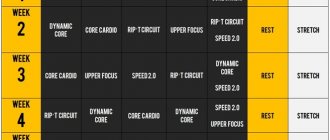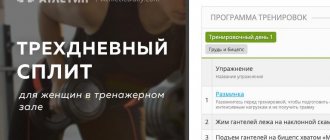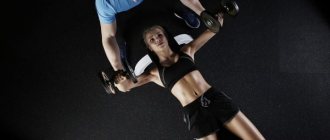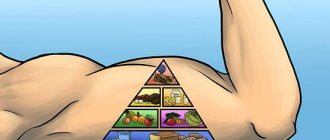First year training program[edit | edit code]
It seems to me that the first year of classes is the most important. After all, your future attitude towards exercise depends on how you start training. Miracles don’t happen, be patient and don’t expect instant results: after just a few months you definitely won’t turn into an athlete with rippling muscles. This will come with time, but there is a long way to go; I hope my recommendations will help you pass it successfully.
During the first months, the goal of the classes is to master the correct technique for performing the exercises. Both your safety (you will not get injured) and the effectiveness of your exercises (correct execution of this or that exercise will affect the target muscle group) depend on this.
You shouldn't rush off the bat. Entering the world of bodybuilding should be smooth. A gradual increase in load is the most important thing at this stage. Don't try to immediately determine how much weight you can lift in a bench press or squat.
Unproven technique coupled with weak muscles can easily lead to injury. As a result, training with a barbell will cause you not enthusiasm, but nervous trembling
.
Do not overload yourself “to the fullest” in the first months of training: a body that is not accustomed to work will be very sore. As a result, you will feel as if all the muscles are being torn into small pieces at the slightest movement. Muscle pain the day after exercise is common and is due to the accumulation of lactic acid in the tissues. Gradually getting into the training rhythm will help reduce this problem to a minimum, so the pain, although it will not disappear completely, will be quite tolerable. As a last resort, you can use special sports balms and ointments to reduce discomfort. However, pain also signals that the load to which you exposed yourself the day before has acted exactly in the right direction, which means your muscles are strengthening.
In the first months of training, you should definitely adjust your diet, replacing all “food waste” (ketchups, chips, candies, etc.) with products that will help you build muscle mass or lose excess fat. You need to balance your diet in terms of the amount of proteins, fats and carbohydrates in such a way that the nutrition gives maximum benefit. Remember that approximately 50% of the success of your workouts depends on proper nutrition.
The training method I have proposed is designed for the fact that you will start practicing it in September. Why? It is this month that most smart people choose to take care of their physical fitness: in this case, by the beginning of summer they manage to acquire a more or less athletic appearance. Therefore, September will be the starting point in calculating your methodology (of course, you can easily adjust it to your time frame).
The annual cycle is divided into five training stages. Here is a detailed lesson plan for the first two years. After the athlete trains diligently for a given period of time, he will gain sufficient experience to independently create an annual complex for himself, pursuing his own goals. To help in this exciting activity, he can use the part of the book that is devoted to the peculiarities of training advanced-level athletes.
The first two stages of the first year of classes are introductory. During this time, you will learn how to perform exercises technically correctly and gradually comprehend the basics of training and nutrition. In the third and fourth stages, the athlete gains maximum muscle mass, and in the fifth he undergoes a training course, the goal of which is to develop sculpted muscles.
It should be noted that between each stage you need to take a week's break to give your psyche a rest and to heal the microtraumas that will inevitably appear as a result of training. The enthusiasm accumulated during the rest will help you carry out the next stage more actively.
Many obstacles await you on the path to an ideal figure, but they can be easily overcome if you are thoughtful and responsible about the three components of success: proper nutrition, training and recovery.
.
Training program for advanced
So, you have already gained basic shape and have another 10 months left to reach a competitive level. Here it is worth connecting a system called “split” from the English “splitting”. The idea is that in one workout only one or two muscle groups are worked out, in the next workout - others, etc., so that the muscles have time, on the one hand, to receive maximum attention and load, and on the other, to rest.
There is a classic four-day split, when a large and small muscle group is worked out in each workout and it turns out that each group is worked out once a week. Or a “two plus two” workout, when the load is divided, for example, into top and bottom and the corresponding muscles are pumped.
If you start taking on some weight, adaptation to it will definitely occur after some time. To develop further, you need to constantly increase the intensity of the training itself. It can be increased in two ways: increasing the working weights and decreasing the rest time between repetitions. The fact is that the volume of muscle diameter is directly proportional to muscle strength and vice versa. If you do 4-6 repetitions, adaptation occurs in increasing strength. And if you do it for a large number of repetitions, then the muscle diameter adapts.
First stage (September)[edit | edit code]
Strange as it may sound, you should go to the gym already trained. What does it mean? Before you pick up dumbbells or lie down under a barbell, you need to improve your physical fitness with exercises with your own weight, that is, push-ups and pull-ups. This should be done for one single purpose - to strengthen the ligaments and muscles, so that when performing exercises with weights you do not get injured in the very first workouts.
You need to exercise three times a week, alternating complexes for extensor muscles (pectoral, deltoid and triceps) and flexor muscles (back and biceps). It turns out something like a split (you will learn about what this is in one of the following chapters).
So, we will denote the complexes for the extensor muscles with the letter “A”, and for the flexor muscles with the letter “B”. Then your first month’s training should be carried out according to the scheme presented in table. 5.
Training schedule
| Week 1 | Week 2 | Week 3 | Week 4 | |
| Monday | A | IN | A | IN |
| Tuesday | Rest | Rest | Rest | Rest |
| Wednesday | IN | A | IN | A |
| Thursday | Rest | Rest | Rest | Rest |
| Friday | A | IN | A | IN |
| Saturday | Rest | Rest | Rest | Rest |
| Sunday | Rest | Rest | Rest | Rest |
You will train each group three times over two weeks or six times over a month. This will be enough to engage your muscles and not overload them. Now let's look directly at the sets of exercises.
Complex A
- Wide grip dips.
- Pushups.
- Push-ups from the floor, legs elevated.
- Close grip dips.
- Raising the torso on an inclined bench.
Complex B
- Wide grip chest pull-ups.
- Pull-ups with a wide grip behind the head.
- Pull-ups with a narrow reverse grip.
- Hanging leg raises to the bar.
During the first workout, you perform one set of each exercise, but with the maximum number of repetitions. During the second - two approaches in each exercise. During the third and subsequent workouts - three approaches to each exercise with the maximum number of repetitions of each of them.
To diversify the exercises, you can use the circular principle starting from the second workout: you perform all the exercises once in the order they appear, then repeat this circle one or two more times. Between approaches, do not forget to rest for 3-4 minutes, gradually shortening the pause until you bring its duration to 1.5-2 minutes.
If you cannot do pull-ups, then replace the exercise with a vertical machine row to the chest, behind the head and with a narrow grip. Although the efficiency decreases.
The described complexes can be performed at home or at the stadium. Still, I recommend visiting the gym for this purpose: the sight of your comrades training hard will help you get into a working mood
.
As for nutrition, you should not suddenly switch to a strict diet and rely on sports supplements. What's more, you won't need them at all during your first year of training, so don't waste your money. The fact is that during this time period the body responds very actively to loads and the muscles grow by leaps and bounds. Therefore, balance your diet, and you will succeed without additional investment.
Once you complete this stage, be sure to take a week's break before moving on to the next one. Moreover, it will be much more complicated than the introductory one.
Training program for beginners and its effectiveness
If you decide to take up bodybuilding, it is very important to start training correctly. After all, mistakes can discourage you from studying altogether.
General recommendations for beginners
- The initial training program is designed for approximately 1 year of training. You can’t get hung up on one scheme - the effectiveness of the training will decrease.
- Don't push yourself as hard as possible from the first workout, increase the intensity gradually. Let your body adapt to the stress.
- Don't overwork yourself; you can't train every day. The optimal amount of training is 3-4 times a week, depending on the individual characteristics of the body.
- Training duration is up to 1.5 hours.
- In the initial stages of training, use mainly basic exercises.
- Concentrate on exercise technique.
- In the first year of training, most beginners will find full body programs per workout suitable.
- Don't overeat, eat right.
- To properly work out muscle groups and get enough rest, use split training.
- Build a training plan, use an electronic training diary.
FULL BODY: workout for beginners! Stage 1
Start your exercise with aerobic training. The most accessible and optimal option is running; in addition, you can do swimming, brisk walking, aerobics, etc. During this period, you can exercise every day, preferably in the morning. Before each workout, do a thorough warm-up, try to stretch all the main muscles, perform movements in the main joints with maximum amplitude. Don't make sudden movements. The purpose of the warm-up is to increase joint mobility and improve nutrition of muscles and ligaments.
During the first stage, you need to develop your body's tolerance to stress in order to prepare it for high-intensity strength training. If you are fond of any sports (football, basketball, volleyball, etc.) and are systematically exposed to physical activity, then you can skip this stage. The average duration of the first stage is 2-4 weeks. Before your first strength training session, take a break of 2-3 days to give your body time to recover.
Training program for beginners. Stage 2
- Before starting the exercises, you need to warm up for 10 minutes. The purpose of the warm-up: to raise the heart rate, improve blood circulation in tissues, develop tendons, and raise the tone of the sympathetic nervous system.
- Use working weight in exercises.
- Each exercise begins with a warm-up set: 10 repetitions with 50% of the working weight.
- Each exercise includes approximately 3 sets and 10-15 repetitions. Don't be surprised by the high repetition rate. The training program for a beginner is aimed not so much at stimulating muscles to grow, but at preparing them. With the first power loads, it is necessary to achieve supercompensation in glycogen metabolism, and this requires a greater number of repetitions. There are individual muscles (calves, abs) that require even more repetitions (about 20).
- Each approach should take 30-60 seconds to complete. This period is optimal for strength training.
- Monitor your heart rate during training. The optimal pulse interval is 100-140 beats per minute. If the pulse is lower, then the intensity of the training is too low; if the pulse is faster, then the intensity must be reduced.
Day 1 - back and biceps
- Warm-up
- Deadlift, 2×8
- Bent-over barbell row, 3×8
- Wide grip pull-ups, 3x max.
- Barbell curl, 2×12
- Any abdominal exercise (crunches), without weights, 3 failure sets
- Hitch
Day 2 - Legs and Triceps
- Warm-up
- Squats with a 3×6 barbell
- Leg press 2×18
- Seated calf raise, 3×15
- Close grip bench press 2×12
- French press 1×12
- Any abdominal exercise (crunches), without weights, 3 failure sets
- Hitch
Day 3 - chest, shoulders
- Warm-up
- Wide grip bench press, 5x5
- Dips, 3 failure sets
- Military press, 3×8
- Dumbbell flyes, 2×12
- Hitch
After the third day, you need to take a break for at least two days. Classes in the second stage mode last 1-2 months.
The muscle groups that are worked first during training grow faster and become stronger than other muscle groups.
There is an opinion that beginners should start with a “whole body” workout in each lesson, this is justified by the fact that when performing basic exercises (squats, deadlifts, bench press, pull-ups) hormones are released in sufficient quantities that help recovery after training, which when rarely load does not occur in split systems. One of these people is Professor Seluyanov, who in his laboratory checked the number of hormones before and after the exercise, and if after lifting the barbell for biceps, the number of hormones in the blood was 2-3 units, then after squats or deadlifts it became 5-7 units.
However, other, no less authoritative Russian experts in the field of powerlifting and bodybuilding (Faleev, etc.) believe that no hormonal emissions occur when performing basic exercises. And various effects (for example, attraction) after the same squat are considered not as a release of testosterone, but as a simple increase in blood circulation in the pelvic area. To support their hypothesis, they conducted studies of hormonal levels before and after exercise.
Third stage
The training program for beginners involves moving to the third stage, which is essentially no different from the second, except that the program begins to include more complex exercises, including isolating ones, and the number of repetitions is reduced to 6-10.
After completing the second stage, start studying:
- How to create a training program
- The best training programs for mass
- Effective principles for gaining muscle mass
- Training program for professionals
- High intensity training
You can do the beginner program until your results start to drop (no strength or muscle growth). This usually happens after a few months. After which you need to change the program.
Effectiveness of the program for beginners
This training program for beginners is based on an analysis of the literature, and is a typical basic scheme. The program is suitable for most beginners, but there are exceptions that cannot be predicted and only empirical experience will allow this to be established. A much greater risk of low effectiveness arises when using specific programs that are now widely advertised and promoted. Don't be fooled by marketing, as it has been scientifically proven that basic programs like this are the most effective. Don't expect significant results; they will appear only in the third stage. Don't try to force development and skip stages, this will worsen your progress later.
based on materials
Shall we turn on some music to set the mood?
Now playing:
Open Kluber FM website | iOS app | Android app
Second stage (October, November)[edit | edit code]
Before you start serious training, you should start a journal. Of course, not the same as at school, but somewhat reminiscent of it. In this kind of diary you will enter everything that relates to your activities: a set of exercises that is relevant at the moment, the amount of weights lifted, daily food consumption and its composition, well-being on the day of training and the next day, the results of measuring your muscles, etc. etc. In general, everything that is at least somehow related to the training process. This is necessary so that you can then analyze the records and see in which exercises and under what conditions you saw the most rapid progress, which diet allowed you to gain muscle mass the fastest, etc.
Bodybuilder Diary Sample
| date | — | |||
| Exercise | Weight | |||
| 1st exercise | 1st approach | 2nd approach | 3rd approach | 4th approach |
| 2nd exercise | ||||
| 3rd exercise | ||||
| 4th exercise | ||||
| 5th exercise | ||||
| 6th exercise | ||||
| 7th exercise | ||||
| 8th exercise | ||||
| Nutrition | ||||
| 1st meal | ||||
| 2nd meal | ||||
| 3rd meal | ||||
| 4th meal | ||||
| 5th meal | ||||
| How you feel before training | ||||
| How you feel after training | ||||
| Note | ||||
Once a month, measure the size of your muscles: biceps in a tense state, chest circumference, neck circumference, forearm, waist, hips and lower legs. If the results gradually increase, you are on the right track. If your waistline is increasing at a faster rate, then reduce the amount of simple carbohydrates, otherwise you will turn into a bun!
If you have any difficulties performing a particular exercise, seek advice from more experienced comrades or an instructor at the gym so that they can explain all the intricacies.
Before you begin active training, carefully study the exercises you will be doing.
.
Now let's move on to considering the complex itself. You will perform it as follows: the first two weeks - two workouts (Monday - Thursday or Tuesday - Friday), and starting from the third week they will be held three times (every other day). Since the weights you will use are still very small, you should not be afraid of overload. Your muscles will have time to recover before your next workout.
The first two weeks you should devote only to working out the trajectory of movements. You should not load the barbell or grab heavy dumbbells. Use a bar without weights and light dumbbells to learn exactly how to perform these exercises.
- Bench press on a horizontal bench - three sets of 10 repetitions.
- Wide-grip pull-ups to the chest or rows of a vertical block to the chest - three sets of 10 repetitions.
- Standing barbell press—three sets of 12 reps.
- Standing elbow curls with a barbell - three sets of 12 repetitions.
- French bench press—three sets of 12 reps.
- Raising the torso on an incline bench - three sets with a maximum number of repetitions.
Before starting the complex, warm up thoroughly. Warm-up should take 5-10 minutes. Make rotational movements with your arms, body, squats, swings. Rub your ears to invigorate your ears.
During the first week you will perform each exercise one approach, during the second week you will perform two approaches. Starting from the third week and until the end of the stage, perform three approaches. Preface each of them with a short warm-up. First, do this exercise with a light weight 10-12 times, but not to the point of fatigue, just feel the muscles working to warm them up and prevent possible injuries.
After four weeks, the main goal will be to gradually increase the weight of your working weights. However, this process should not negatively affect either technique or the number of repetitions. You should strictly perform 10-12 repetitions in each approach. As soon as you feel that you are doing all three approaches quite easily, and you still have the strength for two or three additional repetitions, you can increase the weight by 2.5-5 kg and continue working.
Nutrition at this stage should undergo significant changes. To achieve your goals, you need to completely change your diet. Increase your protein intake to the required amount, switch to slow carbohydrates, and remove simple sugars from your diet. It is in the first months that the foundation of your future success is laid - and it is in your best interests that it be strong.
Third stage (December, January)[edit | edit code]
After the first two stages are left behind, you will gradually begin to feel your body: how your muscles work, how they respond to the load they receive. The size of your muscles has already increased somewhat, and your body weight has also increased proportionally.
If you did everything correctly, then the main mass gain came from the muscles. During the first year of training, they are most susceptible to stress and grow even faster than experienced bodybuilders taking anabolic steroids
.
Let's consider the main tasks of the third stage of the first annual training cycle.
There are two of them: expansion of the chest with the help of breathing pullovers and further gain of muscle mass. In addition, we will learn new movements.
Why expand the chest at all? Firstly, due to this, the useful volume of the lungs increases. Secondly, the bone structure expands, and your sunken chick breast is not only leveled out, but also turns into a wide, heroic one. Thirdly, even not too massive pectoral muscles look much more impressive on a wide chest than large muscles on a sunken chest. So there is no alternative!
The chest expansion complex itself is a superset. This term refers to the sequential performance of exercises without interruption. After completing the first approach, rest follows, then exercises that combine squats with light weights and breathing pullovers are repeated the required number of times. The first and second exercises are quite complex technically, so during the first weeks thoroughly study the technique of performing them, which - I repeat once again - is the cornerstone of success.
At this stage we will begin to train our legs. Don’t be lazy, remember that they make up exactly half of the body, so undeveloped lower limbs against the backdrop of a powerful upper body look funny and defective.
You need to train three times a week using two different complexes. One of them focuses on the upper body, the other on the lower body and breathing pullovers. Always pre-workout with a good warm-up to prepare your body for the stress ahead. Use light weights for this.
The information given in table will help you create a training schedule at the third stage. Training schedule. Please note that the stage lasts not four, but eight weeks: the distribution of exercises in weeks 5-8 is the same as in weeks 1-4.
Complex A
- Bench press on a horizontal bench - four sets of 10 repetitions.
- Pull-ups - four sets of 10 reps.
- Seated overhead bench press - three sets of 12 reps.
- Standing elbow curls with a barbell - four sets of 10 repetitions.
- Leg press on the machine - three sets of 15 repetitions.
- Exercise for the calf muscles in a seated barre - four sets of 15 repetitions.
- Raising the torso on an incline bench - four sets of 20 repetitions.
Complex B (superset)
- Back squats - light weight, four sets of 20 reps.
- Pullover with a light dumbbell over a bench - four sets of 20 repetitions.
- Bench press at a 45° angle - three sets of 12 reps.
- Bent-over barbell rows - three sets of 10 reps.
- Alternately bending the arms at the elbow joints with dumbbells - three sets of 10 repetitions.
- French press—three sets of 10 reps.
- Exercise for the calf muscles in the standing barre - three sets of 15 repetitions.
- Raising straight legs while hanging to the bar - three approaches with the maximum number of repetitions.
As mentioned above, the weight in a superset consisting of squats and pullovers is not so important. The technique of its implementation plays a much larger role. When doing squats, you should, at the bottom point, draw as much air into your chest as possible to feel the muscle stretch. When performing a pullover, when the dumbbell is at the lowest point, you also need to inhale as deeply as possible in order to feel the stretching of the chest. This complex works great, especially if you are under 25 years old. However, even after 30 you can achieve good results.
The remaining exercises of the complex are performed in the usual style. The first two weeks you will perform two sets of each exercise, the second three sets, and the following weeks the prescribed number. After a week's rest, you should start a new stage with a reduced load, gradually reaching the planned load. This will protect you from overexertion and related injuries.
Physical development of the child
The baby's muscles are ready to accumulate the strength he will need to crawl, sit and stand on his feet. Physical exercise should be included in your daily routine and not miss a single session. Remember that gymnastics will be beneficial only when the baby does it with pleasure and is not capricious. Let him grab your fingers with his hands or take his fists yourself. Gently pull up so that the chest and shoulders come off the mattress and rise, the body assumes a semi-sitting position. Repeat this several times to strengthen the spine and prepare for new loads.
Start exercising on a fitball - a large gymnastic ball with soft bulges. Place the baby's tummy on a round surface and rock it slightly in all directions. Exercise strengthens the abdominal muscles, develops a sense of balance and coordination of movements. Begin your acquaintance with the projectile very carefully: if the baby gets very scared, the fear will remain for a long time. Elastic spikes work as a massager, the abdominal muscles and internal organs are actively supplied with blood, and the digestive system works better.
A child’s body at 5 months already requires active movements. Use this desire when swimming, on walks, in the country. Raise your child with your arms outstretched, and soon he will learn to hold his body in a horizontal “airplane” position. Swing him by holding his hands; this exercise develops coordination of movements. In the bath, teach your baby to kick the water, imitating swimming. You yourself can come up with many outdoor games that will bring great pleasure to your child.
The fourth stage (February, March, April)[edit | edit code]
This stage is considered the most difficult in the first annual cycle. It is during these three months that the maximum increase in muscle mass and strength should occur. You’ve already been training for almost six months and you know a lot. If you approached the training thoughtfully, then the technique of performing the exercises has been perfected: the barbell no longer dances in your hands, the movements have become precise and beautiful. This, by the way, is one of the signs that the exercise is being performed correctly. Look at the training of more experienced athletes. Even when they lift enormous weights, their actions are careful. There is no wobbling of the barbell and dumbbells, no swaying of the body, they do not bend in half. The trajectory is adjusted to the millimeter. This is exactly what you need to strive for in the first year of training.
The fact that the most difficult stage of the first annual cycle occurs in spring is also not accidental. At this time of year, the body responds very actively to stress and gains lean muscle mass very well. Since in spring there is often a deficiency of vitamins, it is recommended to take special vitamin and mineral complexes, as well as adaptogens (tincture of ginseng, Rhodiola rosea or Echinacea purpurea). This serves as an excellent prevention of chronic fatigue and acute respiratory infections.
Nutrition should also be reviewed. As the emphasis shifts to heavy compound exercises, complex carbohydrates, such as those found in durum wheat cereals or pasta, should occupy a significant place in your diet. The amount of potatoes consumed must be controlled, as they are rich in starch, which contributes to the accumulation of fat. Carefully monitor your waist size: if it starts to increase sharply, reconsider your diet. During this period, you can start taking special supplements. First of all, pay attention to whey proteins and gainers. It is too early to use other drugs.
You should exercise three times a week using two different complexes, pumping each muscle group in each workout. To avoid overwork, load it at different angles.
.
Compared to the third stage of classes, the training schedule will look similar.
Complex A
- Bench press on a horizontal bench - four sets of 6-8 repetitions.
- Pull-ups - four sets with maximum reps.
- Bench press while seated - four sets of 8-10 reps.
- Bend your arms at the elbow joints with a barbell while standing - four sets of 8-10 repetitions.
- Leg press on the machine - four sets of 15-20 repetitions.
- Exercise for the calf muscles in the barre while sitting - four sets of 15-20 repetitions.
- Raising the torso on an incline bench—four sets of 20 repetitions.
Complex B
- Squats with a barbell on your shoulders—four sets of 10-15 reps.
- Bench press on an incline bench - four sets of 8-10 repetitions.
- Bent-over barbell rows - four sets of 8-10 reps.
- Standing barbell press - four sets of 10-12 reps.
- Alternating bending of the arms at the elbow joints with dumbbells - four sets of 10-12 repetitions.
- Exercise for the calf muscles in the standing barre - four sets of 15-20 repetitions.
- Raising straight legs while hanging to the bar - four sets with the maximum number of repetitions.
These complexes are still slightly different from what you did before. During the first week you will perform two sets of each exercise, during the second week - three, and starting in the third week - four. The rest between them should be 2 minutes. For the first two weeks, you will perform the maximum number of repetitions specified for each exercise. For example, if it says “four sets of 8-10 reps,” then you should do the appropriate number of sets of 10 reps, and starting in the third week, four sets of 8 reps.
The principle of performing the exercises will also change somewhat. You should not do all four sets with the same weight. The algorithm looks like this: for example, you know that you can repeat the bench press on a horizontal bench 8 times. Then, after warming up, you will do the first approach with a weight of 40 kg for 8 repetitions, the second approach - 50 kg for 8 repetitions, the third - 60 kg for 8 repetitions, and only the fourth approach - with a maximum of 70 kg, also for 8 repetitions. Although at first you most likely will not succeed, and you will only manage 5-6 repetitions.
So the immediate goal is to do 8 reps on your last set. As soon as you reach this goal and feel that you still have the strength to perform 1-2 repetitions, increase the weight in the entire chain by 2.5-5 kg and begin to conquer a new peak.
The described principle of execution is suitable for all exercises. You will only have one working approach, in which you must give your 100%. Try to gradually increase the weight of the weights. On average, the increase should be 2.5 kg in the bench press and 5 kg in the squats every two weeks. Just pay close attention to your technique and try to perform the exercises cleanly, without the help of other muscles.
During this period, and in general during the first year of training, do not try to lift your maximum weight for the first time, you are not yet ready for this. Of course, everyone is interested in knowing how much they can bench press, but remember that it is very easy to get injured, but the time spent on treating it will negatively affect your overall progress.
Do not resort to the help of your comrades. If you feel that you cannot do the required number of repetitions, place the barbell on the racks and set the correct weight.
When performing exercises such as bench presses, squats, etc., someone should be there to support you. But don't help!
What results can you achieve in 31 days by training only with kettlebells (training program)
Many people underestimate such a projectile as a kettlebell.
Although it is capable of developing almost 90% of a person’s muscles, when, for example, the same exercise machine is only a couple. Well, a big plus is that when you buy a kettlebell, you pay once, and you purchase a gym membership monthly. But as we all remember, almost everyone in the Soviet family had a set of weights 16, 24, 32 kg and a small row of dumbbells; I think many had it lying around in the barn.
Is it possible to get in shape with just weights? Of course, take kettlebell lifters for example, namely those who just came to train with kettlebell lifting. A month later, they come out of there as strong guys, broad shoulders, powerful trapezius muscles.
Of course, we can’t say that they have become Schwarzeneggers, but the general appearance of the athlete is visible.
Personally, I recently conducted an experiment for myself, training for a whole month using weights. It was 16kg, I did clean and jerks, snatches, swings and kettlebell rows to the chin. In addition to good nutrition and quality sleep, I gained +3kg. Of course not pure muscles, but it looked harmonious. Especially when you haven’t been involved in sports for almost 2 years and suddenly start.
Below is a photo of what I managed to achieve with kettlebell training.
Now let's get to the fun part - the workout program.
31 Day Kettlebell Training Program
Note:*before you start training, be sure to stretch your shoulder joints, arms and hands, as they will be most involved.
I would like to point out that we will perform the exercise with a 16kg kettlebell.
We will train 3 times a week; this system is especially suitable for those who have just started training or have decided to train after a long break.
All other days, we will not drink beer and lie on the couch, but will fully recover from training. For example, monitor high-quality nutrition, get a full 8 hours of sleep, and if possible, then steam your muscles in a bathhouse or sauna.
First training.
To begin with, in order to warm up the body and not resort to such technically complex exercises as the clean and jerk, we do kettlebell rows to the chin. We perform 3 sets of 12 times.
After which, we move on to the kettlebell push and perform 5 approaches 8 times on each arm.
Second training session.
Again, you need to start with a warm-up, and then with a warm-up exercise, kettlebell rows to the chin. By the way, this exercise works the trapezius muscles and shoulders very well. All the same, 3 sets 12 times.
Next we move on to kettlebell jerks. For those who do not know how to perform this exercise correctly, I present the technique above. There will be 5 approaches of 15 times. Don't be scared by the numbers, this exercise is actually not difficult.
Third training.
The final workout of this week, in which we will pay a little attention to our hands. After all, hands play a very important role in kettlebell lifting. We take the weight in both hands and perform biceps curls 3 sets of 10 times.
Now let's focus on the triceps. Carefully throw the weight behind your head, while holding it with both hands. And we perform extensions with a kettlebell 3 sets of 8 times.
Congratulations, the training week is over, now you need to repeat it all next week. If you feel that these exercises are easy for you, increase the repetitions.
And with you was the online men's sports magazine Muscle Project! I look forward to your feedback on this technique in the comments.
Source
Fifth stage (May)[edit | edit code]
The last stage of the annual cycle occurs in May. Summer is coming, the beginning of the beach season, time to put on a T-shirt and show everyone your newly acquired figure. If you trained hard all year, ate right and followed a recovery regime, then your muscle mass gain will be from 5 to 10 kg. The volume of muscles also increased noticeably, so that the old clothes began to crack in the shoulders and trying to bring the arms in front of oneself became an unsafe task. However, there is one more small finishing touch left - you need to make your figure more rigid and prominent. After all, along with muscles, you have also built up a certain amount of fat, which you now need to get rid of so that the treasured cubes appear on your abs, and all three heads are visible on your deltoids. Of course, your muscles will not have champion definition (this is too long and troublesome), but you will be guaranteed admiring glances from girls.
First of all, you need to once again adjust your diet. After all, nutrition plays the most important role in building a hard and sculpted body. Using the recommendations of professionals, you can create your own diet or, alternatively, take a ready-made example as a model. The diet described below has been tested many times and gives excellent results. The only problem is that it determines nutrition for two months, and you will only have one at your disposal. It's not scary. Given the short duration of your classes, you can only use the first part.
The set of exercises you will have to do will differ markedly from those described above. The fact is that you are not yet ready to withstand the loads that are intended for experienced athletes.
You will have to exercise three times a week, doing the same exercises as in the fourth stage, only the number of repetitions will increase and you will start doing four approaches from the very first week. In each exercise, try to perform the maximum number of repetitions, without going above the top bar (better increase the weight of the weight), but also without falling below the set limit (in this case, you should reduce the weight of the weight). The rest between sets is no more than 1.5 minutes, and ideally it should be 1 minute.
Complex A
- Bench press on a horizontal bench - four sets of 12-15 repetitions.
- Pull-ups - five sets of as many reps as possible.
- Bench press while seated - four sets of 12-15 reps.
- Bend your arms at the elbow joints with a barbell while standing - four sets of 12-15 repetitions.
- Leg press on the machine - four sets of 20-30 repetitions.
- Exercise for the calf muscles in the barre while sitting - four sets of 20-30 repetitions.
- Raising the torso on an incline bench - four sets with a maximum number of repetitions.
Complex B
- Squats with a barbell on your shoulders - four sets of 15-20 repetitions.
- Bench press on an incline bench - four sets of 15-20 repetitions.
- Bent-over barbell rows - four sets of 12-15 reps.
- Standing barbell press - four sets of 12-15 repetitions.
- Alternate bending of the arms at the elbow joints with dumbbells - four sets of 12-15 repetitions.
- Exercise for the calf muscles in the standing barre - four sets of 20-30 repetitions.
- Raising straight legs while hanging to the bar - four sets with the maximum number of repetitions.
This stage is very stressful. It will be difficult to recover from such loads, even if you work with less weight. As the intensity of exercise increases, you can begin to use some pharmacological drugs and recovery agents. Of course, we are talking about completely safe substances that will support your immune system at the proper level and help you successfully survive this difficult period.
- Ginseng tincture stimulates the immune system. Take 1 teaspoon 3 times a day half an hour before meals.
- Riboxin will help the heart muscle cope with the increased intensity of training. Take 1-3 tablets 3 times a day.
- Glutamine strengthens the immune system and improves overall performance.
- Multivitamins and vitamin C stimulate metabolic processes in the body.
- Festal improves digestion against the background of increased consumption of protein foods.
- A sports fat burner is necessary for those athletes who have problems with excess weight.
After completing this stage, do not immediately pounce on cakes and sweets. It's better to give them up altogether. Gradually introduce carbohydrates into your diet while reducing the amount of protein you consume.
Since the next training year doesn't start until September, use the summer months wisely to get active. Don't forget to eat right and lead a healthy lifestyle
.
To stay in shape, periodically perform the complex of the first month of training. During this time, old microtraumas will heal, you will recharge with energy and approach the next training year in excellent physical shape, eager to train and conquer new heights.











